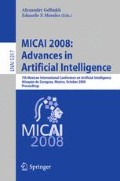Abstract
Data clustering is an important part of cluster analysis. Numerous clustering algorithms based on various theories have been developed, and new algorithms continue to appear in the literature. In this paper, supposing that each cluster center is a gravity center and each data point has a constant mass, Newton’s law of gravity is transformed from m/d 2to 1/d 2. According to adapted the law, we have proposed novel method called Gravitational Fuzzy clustering. The three main contributions of new algorithm can be summarized as: 1) it becomes more sophisticated technique by taking advantages of K-means, fuzzy C-means and subtractive clustering methods, 2) it removes the dependence on initial condition by taking account of the gravitation effect, 3) it improves the cluster centers by means of the gravity center of clusters. We illustrate the advantage of the resulting of gravitational approach with several examples.
Access this chapter
Tax calculation will be finalised at checkout
Purchases are for personal use only
Preview
Unable to display preview. Download preview PDF.
References
Hekim, M., Orhan, U.: A Validity Measure for a New Hybrid Data Clustering. In: International Symposium on Innovations in Intelligent Systems and Applications, Istanbul, pp. 70–74 (2007)
Jain, A.K., Murty, M.N., Flynn, P.J.: Data Clustering: A Review. ACM Computing Surveys 31(3), 264–323 (1999)
Jain, A.K., Duin, R.P.W., Mao, J.: Statistical Pattern Recognition: A Review. IEEE Transactions on Pattern Analysis and Machine Intelligence 22(1), 4–36 (2000)
Berkhin, P.: Survey of Clustering Data Mining Techniques. Grouping Multidimensional Data, 25–71 (2006)
Cheng, Y.: Mean Shift, Mode Seeking, and Clustering. IEEE Transactions on Pattern Analysis and Machine Intelligence 17(8), 790–799 (1995)
Comaniciu, D., Meer, P.: Mean Shift: A Robust Approach toward Feature Space Analysis. IEEE Transactions on Pattern Analysis and Machine Intelligence 24(5), 603–619 (2002)
Comaniciu, D.: An Algorithm for Data-Driven Bandwidth Selection. IEEE Transactions on Pattern Analysis and Machine Intelligence 25(2), 281–288 (2003)
Tsoukalas, L., Uhrig, R.: Fuzzy and Neural Approaches in Engineering. John Wiley & Sons, Inc., NY (1997)
Yu, J.: General C-Means Clustering Model: A Unified Approach to the Theories and Methods of Partitional Clustering Algorithms. Technical Report, AI Lab, Northern Jiaotong Univ., Beijing (2003)
Baraldi, A., Blonda, P.: A Survey of Fuzzy Clustering Algorithms for Pattern Recognition-Part I and II. IEEE Transactions on Systems, Man and Cybernetics, Part B 29(6), 778–801 (1999)
Baraldi, A., Blonda, P., Parmiggiani, F., Pasquariello, G., Satalino, G.: Model Transitions in Descending FLVQ. IEEE Transactions on Neural Networks 9(5), 724–738 (1998)
Li, R.P., Mukaidono, M.: Gaussian Clustering Method Based on Maximum-Fuzzy-Entropy Interpretation. Fuzzy Sets and Systems 102(2), 253–258 (1999)
Ross, T.J.: Fuzzy Logic with Engineering Applications. McGraw-Hill, New York (1995)
Hand, D.J., Daly, F., Lunn, A.D., McConway, K.J., Ostrowski, E.: A Handbook of Small Data Sets. Chapman and Hall, London (1994)
Author information
Authors and Affiliations
Editor information
Editors and Affiliations
Rights and permissions
Copyright information
© 2008 Springer-Verlag Berlin Heidelberg
About this paper
Cite this paper
Orhan, U., Hekim, M., Ibrikci, T. (2008). Gravitational Fuzzy Clustering. In: Gelbukh, A., Morales, E.F. (eds) MICAI 2008: Advances in Artificial Intelligence. MICAI 2008. Lecture Notes in Computer Science(), vol 5317. Springer, Berlin, Heidelberg. https://doi.org/10.1007/978-3-540-88636-5_50
Download citation
DOI: https://doi.org/10.1007/978-3-540-88636-5_50
Publisher Name: Springer, Berlin, Heidelberg
Print ISBN: 978-3-540-88635-8
Online ISBN: 978-3-540-88636-5
eBook Packages: Computer ScienceComputer Science (R0)

